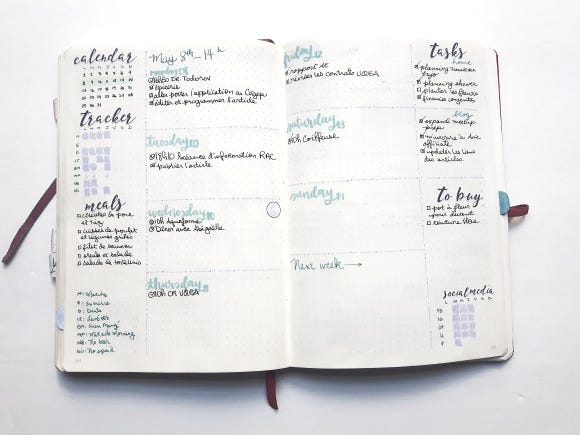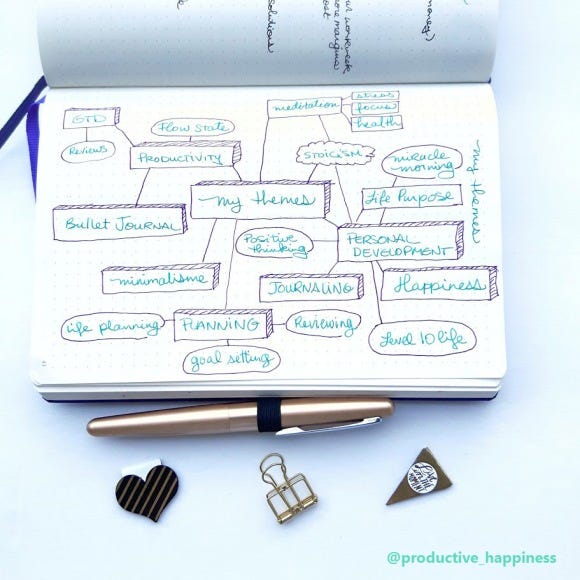Why I chose analog for my personal productivity system
Why analog is superior to digital, and how to integrate both
When I was a kid, I was one of the first to get a personal computer, you know, the ones with the huge floppy disks? My father was into gadgets and technology, he had a cellphone before the frenzy, and we were the first in our neighborhood to have access to the internet. You’d think that my father’s love for gadgets would turn me into a digital devotee. Sure, I like my shiny new Remarkable 2 and my many productivity apps, but I have a love for analog that no app could take away.
With my trusted notebook in hand, I will plan my articles, set goals, track my habits and write down my tasks on a daily basis. And there’s a very good explanation as to why analog note-taking and goal-setting actually work best than digital. In a study conducted in 2011 by Mangen and Velay, the researchers discovered that the “physical action of forming letters while writing by hand is important in helping the brain remember the letters that are written.” Handwriting activates more parts of the brain than the act of typing, which leads to more retaining of the information. This is explained by the kinesthetic aspect of handwriting that allows us to learn differently.
Another study conducted with students required to take notes by hand has shown that the act of handwriting forces us to summarize and paraphrase information, contrary to the act of writing verbatim when typing. This processing of information has shown better grades in the handwriting students, who remembered the details easily, but also could explain complex concepts with ease.
In our day and age, most of us are stuck to a screen all day, be it our cell phone, computer, TV or tablet. We seldom get a break from screens. Planning in my notebook allows me such a break which feels very refreshing. Also, when I log into my cellphone or tablet, I tend to be distracted by notifications or checking emails or Facebook compulsively. When I use my notebook, there are no distractions, only the blank page staring at me. It helps me focus and stay on the task way more.
The perfect analog system
Back when I was working a corporate job, I used to track my tasks in Outlook, but that method did not work well for me. So I created a daily paper-based system to track my tasks, as well as a weekly planner that would stay on my desk to make sure I knew what needed to be done during the week. It worked perfectly, and since it was paper-based, I could tweak it as I went and improve on it at any time. Later, I discovered in an article by Lifehacker, a productivity system that would change the way I worked, planned and set goals: The Bullet Journal.
I fell in love instantly with the structure, but also the freedom that the Bullet Journal offered me. It was also a way to express my creativity and a great analog solution for my tasks and projects. In this system, I create daily, weekly and monthly to-dos, goal-setting spreads every quarter, project plans, trackers, various lists, and I even use it to brainstorm my articles using mind maps. Avid Getting Things Done user, I adapted the Bullet Journal system to incorporate my favourite methodology. Allowing me either simplicity or complexity, adapting to my needs and planning style, the analog notebook that never leaves my side gives me all I need to be productive.
A hybrid system
Even though I sing the praise of analog, I still use some digital tools in my productivity workflow. Getting Things Done advocates not to keep tasks and ideas in our head but to quickly capture them in a trusted system. As it is not convenient to take notes on the go, while running errands or taking the subway, I like to use Notion on my phone to capture tasks outside my home. For ideas or quick note-taking, I like to use Google Keep, which is a very simple note-taking app with nice functionalities.
Evernote has always been my go-to for long-term storage of notes and documents. I use it mostly for the web clipper, but I also like to use the capture tool to take pictures of my notebook when I want to be able to access information anywhere. The OCR allows me to search my handwritten notes and retrieve information super easily.
Last but not least, I use Google Calendar for all my appointments, and for my editorial calendar. As great as is the Bullet Journal, I find it lacks the ability to store information far in the future, such as medical appointments set in a few months. I store all my appointments in Google Cal and transfer them to my notebook for the current week.
Digital tools will continue to fascinate me and I will keep trying the new productivity apps everyone raves about, but analog will keep its place in my daily workflow no matter what. I like being old-school and making things pretty in my notebook, and I like to keep my old notebooks in my library. I open one up once in a while and feel the nostalgia of seeing all these projects I’ve been working on and the amazing adventures I’ve been through over the years.
Try it, even for a few days. Keep a notebook by your side and write your ideas, and your projects, make a list of your goals and brainstorm for your next ventures. You might enjoy it! And if you do, leave a comment below and let me know what you tried and what you enjoyed. What do you have to lose?





